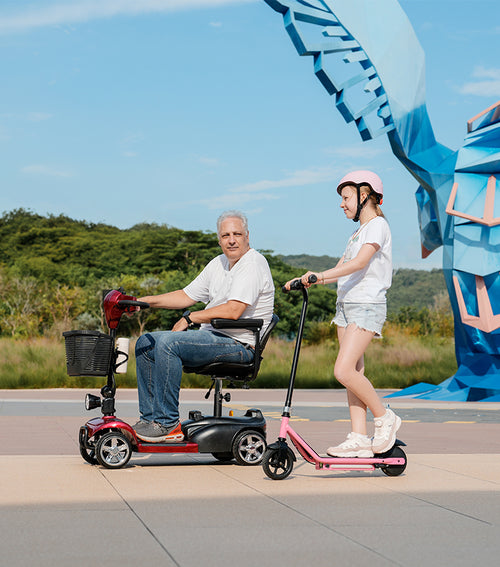
When Will Private E-Scooters Be Legal in the UK? 2025 Update!
Electric scooters, often called e-scooters, have transformed the way people travel in busy cities, offering a fast, affordable, and eco-friendly solution for short commutes.
In the UK, rental e-scooters have become a familiar sight in many towns and cities thanks to government-approved trials. However, privately owned e-scooters are still illegal to ride on public roads, pavements, and cycle lanes, creating a frustrating gap for those who want to own and use their own devices.
As we head into 2025, pressure is mounting for the UK government to provide clear, consistent legislation that supports the safe and legal use of private e-scooters. Recent comments from Transport Secretary Louise Haigh have reignited hopes that new laws could be introduced soon, potentially bringing the UK in line with other countries where private e-scooters are already part of everyday transport.
In this section, we’ll explore the current legal situation, what’s driving the push for change, and when private e-scooters might finally be given the green light for legal use on UK roads.
Are privately owned e-scooters legal in the UK?
In the UK, standard privately-owned electric scooters are not road-legal. The only legal way to ride an e-scooter on UK public roads is by using an approved rental e-scooter within a government trial scheme in designated areas. Until new legislation is introduced, privately-owned e-scooters can only be used on private land with the landowner’s permission.
The law treats them as motor vehicles, meaning they would require registration, insurance, tax, and compliance with specific construction and safety standards, requirements that the vast majority of consumer e-scooters cannot meet.
By contrast, rental e-scooters have been permitted in select towns and cities since 2020 through government-approved trial schemes. These trials, still running in 2025, are designed to assess the safety, practicality, and environmental benefits of e-scooters as part of the UK’s wider transport network.
This legal divide, where rented e-scooters are allowed in certain areas but privately owned ones remain banned, has caused ongoing public debate. Many riders and industry experts are calling for clearer regulations that reflect the growing demand for sustainable, personal micro-mobility solutions.
Government Plans for Legalising Private E-Scooters in 2025
The UK government has signalled that 2025 could finally be the year private e-scooters become legal on public roads, bringing long-awaited clarity to owners and riders. New legislation, expected in 2025, aims to introduce a clear legal framework to ensure safety, accountability, and accessibility to private e-scooter owners.
What Might the 2025 Legislation Include?
1. Roadworthiness Standards
The government is likely to set strict technical requirements for private e-scooters. These could include a maximum speed limit of 15.5 mph, reliable braking systems, front and rear lights, and high-visibility reflectors to keep riders visible in low-light conditions.
2. Registration and Insurance
Private e-scooters may need to be registered, similar to how certain bicycles or mopeds are in other countries. Compulsory third-party insurance could also be introduced to cover accidents and liability, ensuring that both riders and pedestrians are protected.
3. Licensing and Training
Riders might be required to hold at least a provisional driving licence. The government could also introduce mandatory training courses, much like cycling proficiency schemes, to equip riders with essential road safety skills.
4. Defined Usage Zones
E-scooters are expected to be allowed on roads and cycle lanes but remain prohibited on pavements to protect pedestrians. Local councils may gain powers to create micromobility lanes, designate no-go zones, or manage shared use areas.
5. Enforcement Mechanisms
Legislation will likely include clear penalties for violations, such as riding on pavements, speeding, or ignoring traffic rules. Emerging technology, like GPS tracking, speed limiters, and geofencing, could help ensure compliance and reduce strain on police resources.
While the benefits of private e-scooter legalisation are compelling, reduced congestion, lower emissions, and more affordable travel, challenges remain. Policymakers must balance the needs of pedestrians, cyclists, and drivers in crowded urban areas. Accessibility and affordability will also be important, ensuring that e-scooters remain a viable transport option for all income levels.
If passed, the 2025 legislation could mark a turning point in the UK’s micromobility revolution. By introducing clear rules and embracing innovation, the government has the opportunity to make e-scooters a safe, sustainable, and widely accepted part of the transport network.
What to Expect When Private E-Scooters Become Legal
If private e-scooters become legal in the UK, riders can expect a set of clear rules designed to ensure safety, accountability, and responsible use. Similar to rental e-scooter schemes already operating in some cities, private models will likely face speed restrictions, safety equipment requirements, and strict usage guidelines such as the following:
1. Licensing and Insurance
You will almost certainly need a provisional or full UK driving licence with a Category Q entitlement to operate a private e-scooter legally. Third-party insurance is expected to be mandatory, helping cover accident liability. Failure to comply could result in a £300 fine and six penalty points on your licence.
2. Technical Standards
To meet UK road safety requirements, private e-scooters will likely have to comply with specific technical standards. This may include:
-
Maximum speed limit of 15.5 mph (25 km/h)
-
Fully functioning front and rear brakes
-
Built-in lights and reflectors for visibility
3. Where You Can Ride
Private e-scooters will probably be permitted on public roads (excluding motorways) and cycle lanes, just like rental e-scooters. Riding on pavements will remain illegal to protect pedestrians.
4. Safety Measures
-
Helmets – Wearing an approved safety helmet will likely be mandatory.
-
Lights and Visibility – Your e-scooter must have working front and rear lights. Wearing fluorescent or reflective clothing is highly recommended, especially in low-light conditions.
-
Protective Gear – Beyond a helmet, riders are encouraged to wear elbow pads, knee pads, and gloves for added protection.
Penalties For Illegal Use Of Electric Scooters
If you're caught using one unlawfully, you may face multiple serious penalties, including fines, driving licence endorsements, and even seizure of the scooter. Here's a breakdown:
-
£300 fine + 6 penalty points for riding without insurance (an offence many riders cannot guard against, as private e-scooters are not insurable).
-
£100 fine + 3–6 penalty points for riding without a valid driving licence or without the correct entitlement.
-
£50 fine for riding on the pavement or footway.
-
£200 fine + 6 penalty points for using a mobile phone or handheld device while riding.
-
£100 fine + possible penalty points for running a red light.
-
Standard drink-driving penalties (court fines, driving bans, and even imprisonment) if riding under the influence, are treated the same as car drivers.
-
Seizure of your e-scooter, under Section 165 of the Road Traffic Act 1988 for offences like no insurance; and possibly under Section 59 of the Police Reform Act for antisocial riding.
Don’t Have An E-Scooter Yet? Check Out These E-Scooter Models From iScooter
|
Image |
||||||||
|
Model |
||||||||
|
Price |
£208.99 |
£228.99 |
£339.99 |
£399.99 |
£475.99 |
£498.99 |
£635.99 |
£745.99 |
|
Motor |
350 W |
350 W |
500 W |
800 W |
800 W |
800 W |
1000 W |
2000 W |
|
Maximum Range |
12 miles (20km) |
18.6 miles (30km) |
24.8 miles (40km) |
31miles(50km) |
25miles (40km) |
31miles (50km) |
34.2miles (55km) |
50miles(80.5km) |
|
Top Speed |
15.5mph (25km/h) |
18.6mph (30km/h) |
21.7mph (35km/h) |
25 mph (40km/h) |
25 mph (40km/h) |
28mph (45km/h) |
28mph (45km/h) |
38mph(61km/h) |
|
Battery Capacity |
5.2 Ah (187Wh) |
7.5 Ah (270Wh) |
10.4 Ah (374.4Wh) |
17.5Ah (630Wh) |
10 Ah (480Wh) |
15 Ah (720Wh) |
15 Ah (720Wh) |
17.5 Ah (840Wh) |
|
Suspension |
None |
None |
Front and Rear double Suspension |
Front and Rear double Suspension |
Front and Rear double Suspension |
Front and Rear double Suspension |
Front and Rear double Suspension |
Front and Rear double Suspension |
|
Wheel Type |
Pneumatic tires |
Honeycomb solid |
Honeycomb solid |
Pneumatic tires |
Pneumatic tires |
Honeycomb solid off-road tires |
Pneumatic off-road tires |
Pneumatic off-road tires |
|
Net Weight |
26.4 lbs (12 kg) |
26.4 lbs (12 kg) |
34 lbs (15.45 kg) |
44 lbs (20 kg) |
48.5 lbs (22 kg) |
57.43lbs (26.05kg) |
60.16lbs (27.29kg) |
73.85lbs(33.5kg) |
|
Water Resistance |
IP54 |
IP54 |
IP54 |
IP54 |
IP54 |
IP54 |
IP54 |
IPX4 |
|
Load Capacity |
220lbs(100kg) |
220lbs(100kg) |
264lbs(120kg) |
264lbs(120kg) |
264lbs(120kg) |
330lbs(150kg) |
330lbs(150kg) |
330Ibs(150KG) |
|
APP |
None |
Old version: KCQ APP New version: Tuya APP |
MiniRobot |
iScooter |
Minirobot APP |
Minirobot APP |
None |
Minirobot APP |
|
Climb Ability |
15% |
15% |
20% |
20% |
25% |
25% |
30% |
25% |
|
Tire Size |
8.5'' |
8.5'' |
10'' |
10'' |
10'' |
10'' |
10'' |
10'' |
|
Light |
Headlight+Break light |
Headlight+Break light |
Headlight+Break light |
Headlight+Break light+Turn light |
Headlight+Break light+Turn light+Ambient light |
Headlight+Break light+Turn light+Ambient light |
Headlight+Break light+Turn light+Ambient light |
Headlight+Break light+Turn light+Ambient light |
|
Driver |
Rear |
Front |
Front |
Rear |
Rear |
Rear |
Rear |
Rear |
|
Braking |
Rear hub brake + hidden electronic brake |
Front electronic brake+rear disc brake |
Front electronic brake+rear disc brake |
Front and rear disc brake + electronic brake |
Front and rear disc brake + electronic brake |
Front and rear disc brake + electronic brake |
Front and rear disc brake + electronic brake |
Double handle front and rear disc brakes + hidden power-off brake |
|
Dimensions |
105*45*110 cm |
108*43*112 cm |
115*55*117cm |
118*52*118CM |
117*64*138cm |
118*60*123cm |
118*60*123cm |
117*23*130cm |
Conclusion
The question of when private e-scooters will be legal in the UK has been on the minds of thousands of riders for years. With new legislation expected in 2025, the UK is finally moving towards a clear legal framework that will allow private e-scooter use on public roads and cycle lanes, while ensuring strict safety standards, licensing, and insurance requirements.
If passed, these laws could mark a major shift in how we travel, offering a cleaner, more affordable, and more efficient mode of transport. However, the exact date of legalisation will depend on the government’s legislative process and final approval.
For now, the best way to prepare is to stay informed about the latest UK e-scooter law updates and ensure your e-scooter meets likely future requirements such as speed limits, lights, and braking systems. When the law changes, responsible riders will be ready to enjoy their e-scooters legally and safely, ushering in a new era for micromobility in the UK.
👍 Buying Guide | 🚴♂️ Riding Guide
📋 Feature Guide | ❓ Common problem
Product category
Electric Scooter
Fast Electric Scooters | Off Road Electric Scooter | Electric Scooter 45km h | Electric Scooter For Adults










































![Electric Scooter UK Law Change [2025 Guide Update]](http://www.iscooterglobal.co.uk/cdn/shop/articles/i9_series_electric_scooter_{width}x.jpg?v=1755081129)







Article tags :
Leave us a message